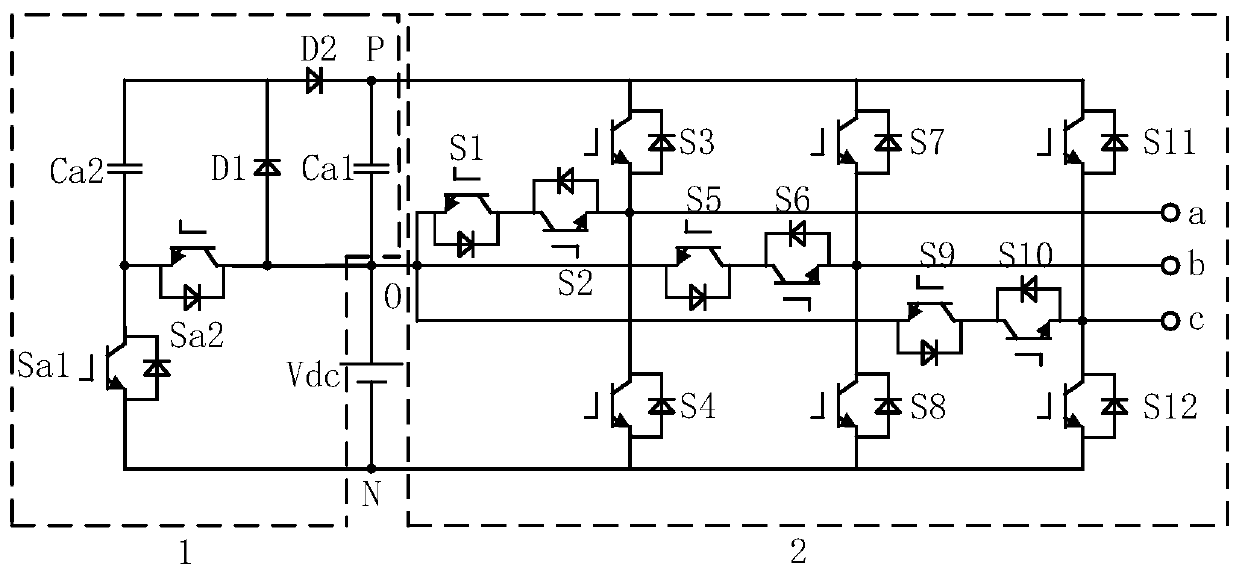A three-phase three-level inverter based on switched capacitors
A technology of three-level inverters and switched capacitors, which is applied to electrical components, output power conversion devices, and conversion of AC power input to DC power output. It can solve the problem of voltage imbalance without capacitors and DC bus capacitor voltage imbalance , Capacitor voltage imbalance and other issues
- Summary
- Abstract
- Description
- Claims
- Application Information
AI Technical Summary
Problems solved by technology
Method used
Image
Examples
Embodiment 1
[0025] The first structure of the capacitor voltage stabilizing unit 1 is specifically as follows:
[0026] Including a first capacitor Ca1, a second capacitor Ca2, a first power switch tube Sa1, a second power switch tube Sa2, a first diode D1, and a second diode D2; the cathode of the first capacitor Ca1 is connected to the power supply The anode of Vdc, the connection point is marked as O; the anode of the first capacitor Ca1 is connected to the cathode of the second diode D2, and the connection point is marked as P; the anode of the second diode D2 is connected to the first diode D1 Cathode; the anode of the first diode D1 is connected to the connection point O; the anode of the second capacitor Ca2 is connected to the cathode of the first diode D1; the cathode of the second capacitor Ca2 is connected to the collector of the first power switch Sa1 The emitter of the first power switch Sa1 is connected to the negative pole of the power supply Vdc, and the connection point is m...
Embodiment 2
[0028] Combine figure 2 , The second structure of the capacitor voltage stabilization unit 1 includes a third capacitor Cb1, a fourth capacitor Cb2, a third power switch tube Sb1, a fourth power switch tube Sb2, a fifth power switch tube Sb3, and a sixth power switch tube Sb4 . The details are as follows: the negative pole of the third capacitor Cb1 is connected to the positive pole of the power supply Vdc, and the connection point is denoted as O; the positive pole of the third capacitor Cb1 is connected to the collector of the sixth power switch Sb4, and the connection point is denoted as P; The emitter of the power switch tube Sb4 is connected to the collector of the third power switch tube Sb3; the emitter of the fifth power switch tube Sb3 is connected to the connection point O; the anode of the fourth capacitor Cb2 is connected to the emission of the sixth power switch tube Sb4 The cathode of the fourth capacitor Cb2 is connected to the collector of the third power swit...
Embodiment 3
[0030] Combine figure 1 , The output unit 2 adopts a T-type three-phase three-level inverter structure, including the seventh power switch S1, the eighth power switch S2, the ninth power switch S3, the tenth power switch S4, and the eleventh power switch. Switch S5, Twelfth Power Switch S6, Thirteenth Power Switch S7, Fourteenth Power Switch S8, Fifteenth Power Switch S9, Sixteenth Power Switch S10, Seventeenth Power Switch S11, the eighteenth power switch S12;
[0031] The emitter of the seventh power switch S1 is connected to the connection point O; the collector of the seventh power switch S1 is connected to the collector of the eighth power switch S2; the emitter of the eighth power switch S2 is connected to the ninth The emitter of the power switch S3 is connected, and the connection point is marked as the a-phase AC output terminal; the collector of the ninth power switch S3 is connected to the connection point P; the collector of the tenth power switch S4 is connected to t...
PUM
 Login to View More
Login to View More Abstract
Description
Claims
Application Information
 Login to View More
Login to View More - R&D
- Intellectual Property
- Life Sciences
- Materials
- Tech Scout
- Unparalleled Data Quality
- Higher Quality Content
- 60% Fewer Hallucinations
Browse by: Latest US Patents, China's latest patents, Technical Efficacy Thesaurus, Application Domain, Technology Topic, Popular Technical Reports.
© 2025 PatSnap. All rights reserved.Legal|Privacy policy|Modern Slavery Act Transparency Statement|Sitemap|About US| Contact US: help@patsnap.com


